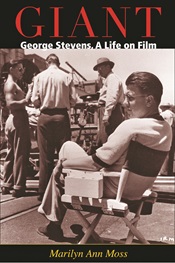By Marilyn Ann Moss
 Former DGA president George Stevens truly grew up with Hollywood. Son of theatrical tent-show performers, he taught himself photography, and—as happened so often in the early days of the industry—lucked into early camerawork with Warner Bros., Ince Studios, and Hal Roach, where he met Laurel and Hardy and began directing, first at Universal and then RKO. Established as a respected director by the time of Alice Adams in 1935, no one could not have predicted the trajectory of his postwar career. As a combat cameraman in WWII—he witnessed D-Day, the Liberation of Paris, and the opening of the Dachau Camp—and on his return to filmmaking, Stevens, a habitual optimist and humanist, said, “I wanted to do very different things than I had done before.” So close was his identification with his darkest postwar movie, A Place in the Sun (1951), that he renamed Montgomery Clift’s lead character George. The profound traumas of his war years deepen the darkness of The Diary of Anne Frank (1959), and the classic Western Shane (1953) seems to understand evil innately and up close. “A private person, whose single passion was making film,” writes Moss, “Stevens’ interior life remained largely hidden.” To the extent that it’s possible, Moss has revealed Stevens and consolidated his status as one of the great studio artists of the ’50s.
Former DGA president George Stevens truly grew up with Hollywood. Son of theatrical tent-show performers, he taught himself photography, and—as happened so often in the early days of the industry—lucked into early camerawork with Warner Bros., Ince Studios, and Hal Roach, where he met Laurel and Hardy and began directing, first at Universal and then RKO. Established as a respected director by the time of Alice Adams in 1935, no one could not have predicted the trajectory of his postwar career. As a combat cameraman in WWII—he witnessed D-Day, the Liberation of Paris, and the opening of the Dachau Camp—and on his return to filmmaking, Stevens, a habitual optimist and humanist, said, “I wanted to do very different things than I had done before.” So close was his identification with his darkest postwar movie, A Place in the Sun (1951), that he renamed Montgomery Clift’s lead character George. The profound traumas of his war years deepen the darkness of The Diary of Anne Frank (1959), and the classic Western Shane (1953) seems to understand evil innately and up close. “A private person, whose single passion was making film,” writes Moss, “Stevens’ interior life remained largely hidden.” To the extent that it’s possible, Moss has revealed Stevens and consolidated his status as one of the great studio artists of the ’50s.
Review written by John Patterson.